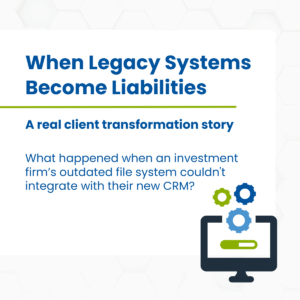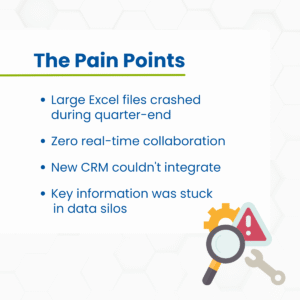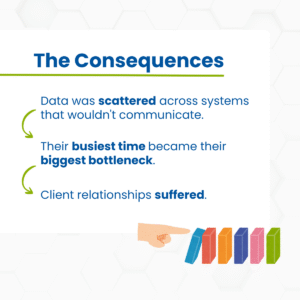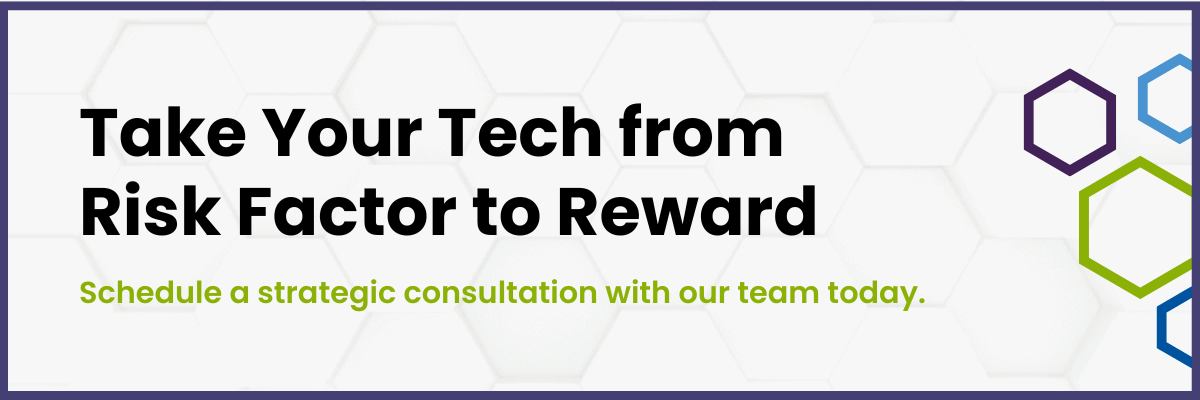Every business owner knows the feeling of quiet dread that comes from technology you don’t have confidence in.
That aging server humming loudly in the corner. The software that “still works fine” despite being several versions behind. The computer that takes 10 minutes to boot up each morning.
While these legacy systems might seem like faithful workhorses that deserve reinforcement rather than replacement, they could actually be putting your business at serious risk.
Join us as we explore what happens when ‘legacy’ becomes ‘liability.’
What Is a ‘Legacy System’?
A legacy system is any piece of technology—hardware, software, or infrastructure—that’s outdated but still in use. These systems often run on obsolete platforms, lack vendor support, or can’t integrate with modern technology.
While they may still perform their basic functions, these tools typically suffer from security vulnerabilities, performance limitations, and compatibility issues that grow more problematic over time.
Common examples include:
- Servers running unsupported operating systems
- Business applications that haven’t been updated in years
- Network equipment that’s well past its recommended replacement date
When Do Legacy Systems Become Business Liabilities?
The trusted systems that have been performing “well enough” so far turn into business liabilities when their risks begin outweighing their benefits. This transition happens gradually, making it easy for businesses to overlook mounting problems until they become critical.
The shift typically occurs when these systems start creating more problems than they solve—whether through frequent downtime, security breaches, or inability to support business growth.
Signs Your Business Technology Is Posing Security Vulnerabilities
Recognizing the warning signs early can help you address such issues before they become major problems.
- Lack of Security Updates
If your software or operating systems no longer receive security patches from vendors, you’re operating with known vulnerabilities that cybercriminals actively exploit.
- Compatibility Issues
When your systems can’t integrate with newer software or hardware, you’re likely running outdated technology that lacks modern security features.
In practice, this could look like old accounting software being unable to connect to modern payment processors or e-commerce platforms, old phone systems that can’t integrate with video conferencing solutions, or even legacy databases that can’t export data in formats that modern analytics tools can read.
You might not immediately flag them as security vulnerabilities, but these integration failures often force businesses to maintain manual workarounds or completely separate systems that ultimately do increase the risk of errors and data breaches.
- No Multi-Factor Authentication
Legacy systems often lack support for multi-factor authentication, which is now a basic requirement for most cybersecurity insurance policies and compliance standards.
- Outdated Antivirus or No Endpoint Protection
Older systems may not support current security software, leaving them vulnerable to modern threats.
- Poor Password Policies
If your systems don’t enforce strong password requirements or regular password changes, they’re creating easy entry points for attackers.
Business Risks Beyond Security Vulnerabilities
While security concerns grab headlines, legacy systems create additional business risks that can be equally damaging:
Productivity Losses: Slow, unreliable systems frustrate employees and reduce efficiency. When staff spend extra time waiting for applications to load or dealing with system crashes, that lost productivity directly impacts your bottom line.
One of our financial services clients experienced this firsthand before we migrated them to SharePoint, solving the severe latency issues that had been slowing down their team.
Limited Scalability: As your company expands, systems that can’t handle increased workloads will become bottlenecks that hold back progress.
Leadership Transition Risks: When key employees retire, they take crucial knowledge about dated systems with them, leaving new leaders with poorly documented environments that can block strategic initiatives. Understanding how to bridge this gap is essential for continuity.
What Happens If You Do Nothing?
Maintaining the status quo usually isn’t the affordable option it may seem. The cost of inaction often exceeds the investment required for modernization.
To see real-world case studies and actual cost breakdowns of what happens when businesses delay necessary technology updates, download our Cost of Inaction ebook.
Expert Insights: Q&A with Anderson Technologies’ CTO
We asked our very own CTO, Luke Bragg, about the realities of legacy system risks and modernization strategies:
Q: What’s one type of legacy system you wish more businesses would retire?
Luke Bragg: I’d say outdated email systems without proper security controls. We see too many businesses still using basic email setups without multi-factor authentication, advanced threat protection, or proper backup systems. Email is often the entry point for cyberattacks, and when that system isn’t properly secured, it puts everything else at risk.
Q: What are the most serious security vulnerabilities you’ve seen caused by legacy tech?
Luke: The scariest situations involve businesses that have legacy systems storing sensitive data without proper access controls. We’ve seen cases where outdated file servers had company-wide access to HR documents, financial records, and client information. When those systems get compromised or when employees leave, there’s no way to control who has access to what. It’s a compliance nightmare waiting to happen.
Q: How would you help, say, an IT manager make a strong business case for upgrading?
Luke: We focus on the business impact rather than technical details. For example, if a client doesn’t have multi-factor authentication, I don’t explain the technical setup—I tell them their cybersecurity insurance could be cancelled or rates could skyrocket because the risk is so high. When business owners and financial teams understand that failing a compliance audit could halt operations or result in significant fines, they see the upgrade as a business necessity, not just an IT expense.
10 Tips for Modernizing Your Legacy Systems
Successfully modernizing legacy systems requires a strategic approach that balances business needs with technical realities:
- Conduct a Comprehensive Assessment: Start with a thorough evaluation of your current technology landscape. Our digital transformation services can help identify which systems pose the greatest risks and provide the highest return on investment when modernized.
- Prioritize by Risk Level: Address the most critical security vulnerabilities first, then tackle performance and compatibility issues based on their business impact.
- Plan for Gradual Migration: You don’t need to replace everything at once. Develop a phased approach that allows for careful testing and minimal business disruption.
- Ensure Proper Data Backup: Before making any changes, implement robust backup systems to protect against data loss during transitions.
- Vet New Technology Carefully: When evaluating replacements for legacy systems, be thorough in your research. Learn how to identify when tech solutions might be too good to be true to avoid costly mistakes.
- Consider Cloud-Based Solutions: Modern cloud or hybrid cloud infrastructure often provides better security, scalability, and cost-effectiveness than on-premises alternatives.
- Train Your Team: Ensure staff are prepared for new systems through proper training and support during transitions.
- Implement Strong Security Controls: Build security into your new systems from the ground up, including multi-factor authentication, encryption, and regular security monitoring.
- Plan for Integration: Choose solutions that can work together and support your business processes rather than creating new silos.
- Partner with Experienced Professionals: Working with experienced IT consultants like Anderson Technologies can help you avoid common pitfalls and ensure your modernization efforts deliver the expected benefits. As specialists in technology modernization, our team can guide you through the entire process.
Tackle That Outdated Tech Before It Becomes a Liability
Legacy systems might seem like a problem you can defer indefinitely, but the risks compound over time. The question isn’t whether your outdated systems will eventually need updating. It’s whether you’ll modernize them proactively or wait until they create costly problems that could have been prevented.
If you’re ready to assess your technology risks, start with a comprehensive IT assessment from Anderson Technologies.
After helping you understand where your legacy systems might be putting your business at risk, our team can help you develop a practical modernization roadmap that fits your budget and timeline while addressing your most critical security vulnerabilities.
Schedule your complimentary IT assessment today to start taking your technology from risk factor to reward.





